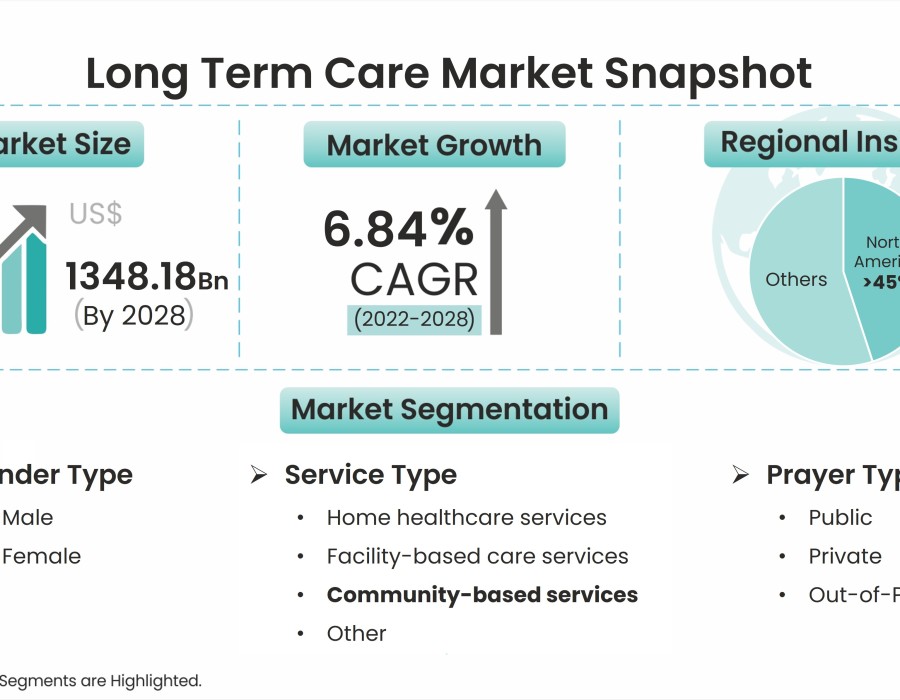Introduction
Long-term care (LTC) has emerged as a critical component of the healthcare industry, as populations around the world are aging rapidly. The demand for long-term care services is on the rise due to factors such as increased life expectancy, declining fertility rates, and the graying of the baby boomer generation.
In this article, we will explore the key trends driving the rising demand for long-term care and delve into projections for the future, shedding light on the challenges and opportunities that lie ahead.
According to Stratview Research, the Long-Term Care Market is expected to reach USD 1348.18 billion by 2028 from USD 845.50 billion in 2021 at a CAGR of 6.84% during the forecast period of 2022-2028.
Long-term care is defined as a service aimed at meeting personal care or a person’s health care need for a long or short period. Long-term care services help the person to live his/her independently and safely when they are unable to do their daily routine activities on their own. These services are provided by various facilities at different places as per the individual’s needs.
To know more about the report, please click here:
https://www.stratviewresearch.com/1605/long-term-care-market.html
Aging Population: The Silver Tsunami
One of the most significant drivers behind the increasing demand for long-term care is the aging population. As medical advancements improve healthcare outcomes and life expectancy, the global population is experiencing a notable shift towards older age groups. The baby boomer generation, born between 1946 and 1964, is a significant part of this trend. With this cohort reaching retirement age, the "silver tsunami" is putting immense pressure on long-term care services.
Rising Prevalence of Chronic Conditions
With age comes a higher likelihood of developing chronic health conditions such as Alzheimer's disease, dementia, heart disease, and diabetes. The prevalence of these conditions is surging, and they often require ongoing medical attention and personalized care. Consequently, long-term care facilities and services are essential to support individuals with complex healthcare needs.
Family Structure and Caregiver Availability
The traditional family structure, where multiple generations live under one roof, has evolved in many societies. As families become more dispersed geographically and women increasingly participate in the workforce, the availability of family caregivers has reduced. This trend has led to a growing demand for professional long-term care services to fill the gap.
Preference for Aging in Place
Many seniors prefer to age in place, remaining in their own homes as they grow older. Aging in place is not only emotionally satisfying for seniors but can also be more cost-effective than moving to long-term care facilities. As a result, there is a rise in demand for home-based care services, including home healthcare and home modifications to accommodate aging needs.
Technological Advancements in Long-Term Care
The integration of technology in healthcare is transforming the long-term care landscape. From telemedicine and remote patient monitoring to electronic health records and assistive devices, technology is enhancing the efficiency and quality of long-term care services. These innovations are facilitating access to care, reducing costs, and improving patient outcomes.
Projections for the Future
Based on current trends, projections for the future demand for long-term care indicate significant growth. By 2050, it is estimated that the global population aged 60 years and above will reach 2.1 billion, nearly double the number in 2019. As a result, the need for long-term care services is expected to surge, creating both challenges and opportunities for the industry.
- Shortage of Long-Term Care Facilities and Workforce
The increasing demand for long-term care is likely to lead to a shortage of facilities and healthcare professionals. The existing infrastructure may struggle to accommodate the growing number of seniors, leading to longer waitlists and potential strains on the quality of care. Additionally, there may be a shortage of trained caregivers, exacerbating the issue.
- Shift toward Home and Community-Based Care
To address the limitations of traditional long-term care facilities, there will be a shift toward home and community-based care models. Governments and healthcare providers will likely invest in initiatives to support aging in place, such as home healthcare services, caregiver training programs, and community-based care centers.
- Integration of AI and Robotics
Artificial intelligence (AI) and robotics will play a significant role in the future of long-term care. AI-powered tools can assist with personalized care plans, medication management, and fall prevention. Robots can provide companionship, support daily tasks, and alleviate some of the burden on caregivers.
- Focus on Preventive Care
To manage the increasing demand for long-term care effectively, there will be a greater emphasis on preventive care strategies. Promoting healthy lifestyles, regular health screenings, and early detection of chronic conditions can help delay the need for intensive long-term care services.
Conclusion
The rising demand for long-term care is an undeniable consequence of global demographic shifts and the evolving healthcare landscape. As the aging population continues to grow, the long-term care industry faces both challenges and opportunities. Embracing technological advancements, promoting home-based care, and prioritizing preventive measures will be crucial in providing high-quality, accessible, and sustainable long-term care services for seniors in the future. Governments, healthcare organizations, and communities must collaborate to develop innovative solutions to meet the rising demand and ensure a better quality of life for our aging population.
About Us
Stratview Research is a global market research firm, offering syndicated and custom research reports along with growth consulting services. Our business intelligence and industry research reports offer clients insightful market data to aid strategic decision-making. These exclusive reports are the result of exclusive research methodology and are available for key industries such as chemicals, composites, advanced materials, technology, renewable energy, and more.
In case of any custom research requirements, please send your inquiry to [email protected] or connect with our experts at +1-313-307-4176.





Comments